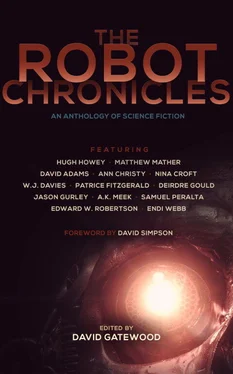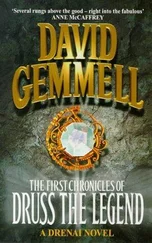With her preparations complete, the shaman began the most important and mystical element of the ritual: awakening the monster’s mind. She breathed a fragment of her own soul into her creation, joining it with the stolen spirit in the sands, giving the monster the spark of life. With pure water, the shaman would give the creature muscles; with lightning, she would feed the abomination; and with fire, she would ignite its consciousness.
Golems were said to have been capable of complex reasoning. Tales spoke of Veledrax the Lustful, who crafted his wife in this way, only to have the creature eventually turn on him and strangle him in his sleep. The tale of Veledrax spans fifty books, and has been retold countless times, but always with one underlying theme:
If you create life, you can never make it too free.
As centuries passed, the specifics of the golem legends faded from the minds of all but the scholars of Toralii history. The nuances of Veledrax’s tale remained, though, as did the lesson he too late discovered—but the justification lost its teeth. Veledrax’s death became something studied only in academic and philosophical circles.
Technology marched on. And science created their own versions of the ancient monsters: constructs. Artificial intelligences, composed of complex neural nets, powered by quantum computers.
Like the golems of old, every single construct was once nothing more than a loose pile of sand.
Quartz sand was the best, but any sand could do as long as it contained high amounts of silicon dioxide. And on Belthas IV, the great forge world in the inner sphere of Toralii space, silicon dioxide was abundant—as were iron, nickel, and thousands of other important pieces of the puzzle. Water, an essential part of any high-heat forge work, was also available in ample supply, comprising over eighty percent of the planet’s surface.
So it was on this world that the Toralii made their constructs. An almost entirely automated process, machines making machines, the process as organic as any creature’s birth.
It all began with the sand. Great treaded harvesters the size of skyscrapers roamed across the planet’s vast southern dunes like titanic snails, sucking up billions of grains and storing them in twin drums on their backs. These harvesters, gorged on the flesh of the world, trundled back to the dumping stations and unloaded their contents into the colossal smelters where the sand was liquefied. The dross was then separated, stored for construction, transported to other factories for use in other projects, or simply discarded. They wanted only the silicon.
The molten silicon was tossed endlessly, machinery working tirelessly to pound out any hint of imperfection. The drums were turned, the molten fluid allowed to settle, the top and bottom few centimeters of the fluid scraped away, removing the impurities which, due to differences in weight, either sank to the bottom or floated to the top. Chemicals were added to bind to stray elements and weigh them down. Methodically, the process edged toward purity.
When the machines and their sensors at last determined that the batch was ready—no more than one alien atom per billion pure silicon atoms—the material would be separated into ingots and stored until the factory demanded it. And once such a request was made, the constructs who administered the facility—nursemaids to a billion of their fellows—would place the order onto vast magnetic trains to be whisked away to the production line.
When a shipment arrived at the production line, it was divided into smaller packages, each one sent to one of the great furnaces that would, once again, return it to liquid. Then the time came to forge. A new construct would arrive, and a single ingot of silicon would be placed into the crucible and heated by application of microwaves until molten. Additional elements were added in trace amounts: arsenic, boron, phosphorus. A process long documented, studied, developed, and made perfect through years of practice. That blend of polysilicon the Toralii called the breath of life would be spun in a centrifuge until it cooled into a perfectly cylindrical crystal.
As a safeguard against error, any remaining impurities would, by nature of the centrifugal force, gravitate toward the top, bottom, and edges of the cylinder. So to further increase the crystal’s viability, its ends were removed, its sides ground down, and the cylinder tested again. The debris from the grinding—and if necessary, the cylinder itself—would be returned to the drums to be smelted and purified once again.
The trimmed cylinder, weighing in at two hundred kilograms or more, would be sliced by a powerful industrial laser into wafers barely more than a few molecules thick. This was the most delicate stage of the operation, the cutting performed in a zero-gravity chamber with a level of precision that left little room for mistakes. Any error would result in the entire sliver being returned to the drums for resmelting, at a considerable waste of energy.
Only those wafers determined to be flawless were passed on to the next stage, to be polished by a low-power laser that burned away any deformities until the surface shone like a mirror. Further chemical treatments followed: baths in compounds to improve the perfection of the perfect—if such a thing were possible—along with coatings of materials allowing the etching to stick. Just as the ancient shamans of old had done.
The etching itself was performed in a dramatic burst of light. The outline, illuminated with a flash of ultraviolet rays passed through a stencil, burned a shadow onto the wafer in the shape of the billions of switches required to form a synthetic mind.
Further chemical treatments, a final touch-up with the laser, and then the switches were bombarded by ions from an electrical field. The ionic infusion was an essential part of the creation process, stabilizing the etching and further sharpening its ability to carry current.
An endless round of tests followed: the wafer would be fed a number of signals and the result would be tested against a known answer. Those that passed moved to the next stage, while those that failed were recycled.
The wafer was then cut into tiny squares, called dies, which formed the heart of the machine’s processor. A single processor usually had many dies, or many cores: numbers over ten thousand were not uncommon.
The current standard Toralii model contained sixty thousand, and although many thought it impossible, the system architects seemed to be able to cram more and more into the same space with every revision.
Processors were grouped based on capabilities, the functions and features of each one exhaustively tested.
At this point, most normal processors ceased their development and were distributed to their end users; but the quantum computers of the constructs underwent an additional two steps. Steps that made them… different.
The first of these steps was what separated the constructs from regular finite-state machines; it was the step that gave birth to the constructs’ imprecise nature, enabling them to be regarded as true artificial intelligences. The dies were bombarded by an electron gun that, through the application of technical wizardry beyond the understanding of all but the most educated and scientific minds of the time, converted the gates from binary states to qubits: a thing beyond a simple switch which, as if by magic, is allowed to be in multiple states simultaneously.
Such a processor transformed a machine from one that simply performed an extremely elaborate series of deterministic steps, to one that operated much as a sentient brain does. Such a machine had all the hardware of a mind, but, as of yet, no software. No raw intelligence, an empty, hollow brain, beyond sleeping, beyond even death—as, while it could certainly be destroyed, death is the cessation of life.
Читать дальше






![Сидней Баундс - The Robot Brains [with w_cat]](/books/196989/sidnej-baunds-the-robot-brains-with-w-cat-thumb.webp)





